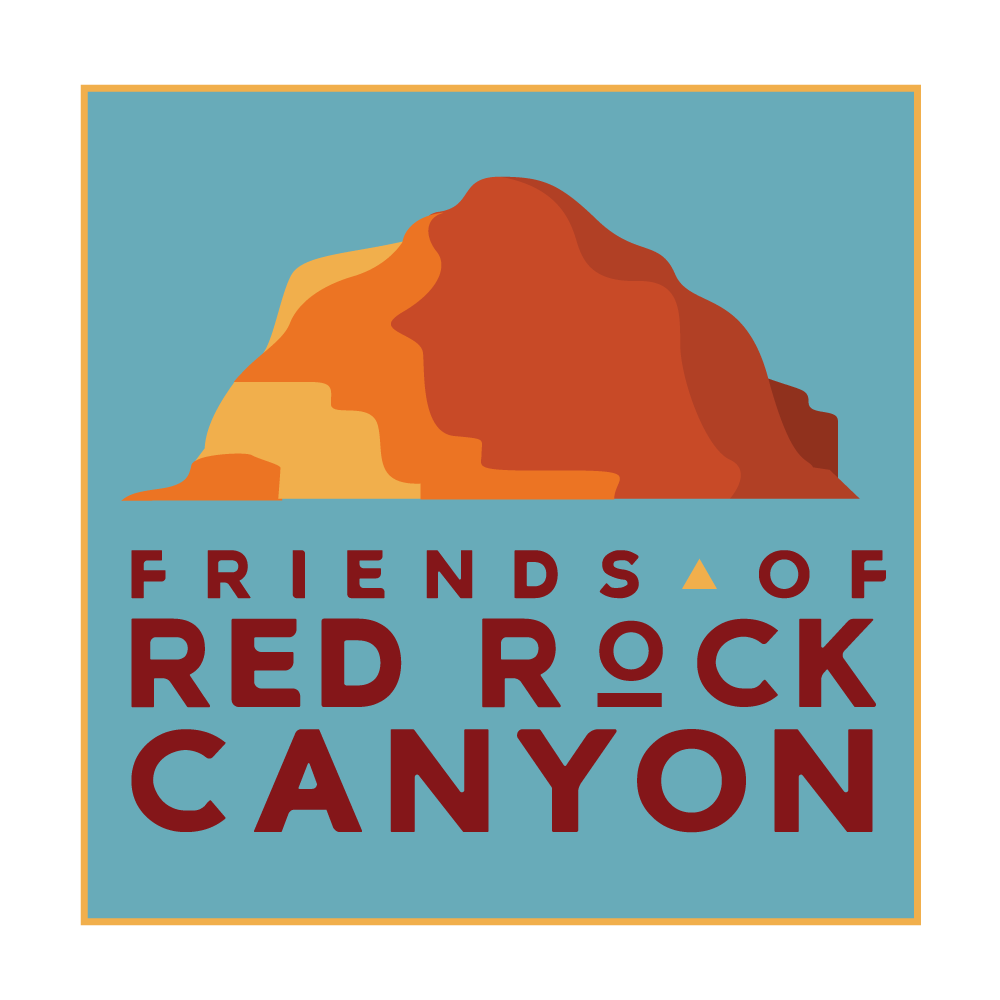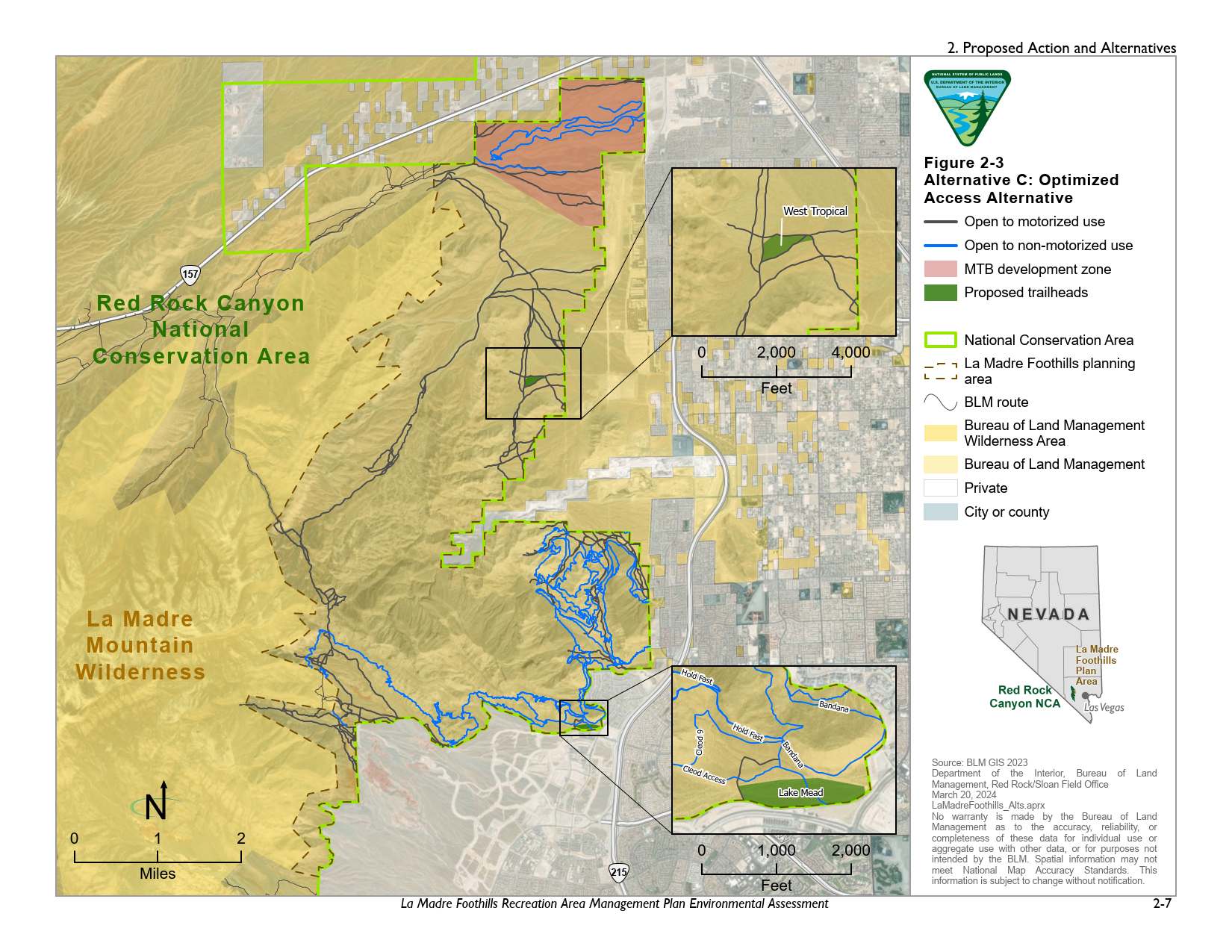
La Madre Foothills Recreation Area Management Plan and Environmental Assessment
Draft RAMP/EA and Frequently Asked Questions
Reading the Draft RAMP/EA
The BLM prepared the La Madre Foothills Draft RAMP to guide the agency’s overall management of recreation in the La Madre Foothills planning area as part of the General Management Plan for the RRCNCA. The La Madre Foothills Draft RAMP includes the following sections:
Chapter 1 identifies the purpose of the RAMP, BLM recreation management framework, relationship to other documents, area overview, guiding principles, and objectives.
Chapter 2 is the proposed management for recreation use, development of facilities, non-motorized trail system management, motorized route network management, visitor health and safety, and adaptive recreation use.
Chapter 3 describes the administration (regulatory action) for resource protection, partnership agreements, and implementation priorities.
Chapter 4 describes management for information and education, including signage placement and map development.
Chapter 5 describes the monitoring, enforcement, and adaptive management associated with implementing the RAMP.
Chapter 6 provides references.
Issues considered in the Draft RAMP/EA
Following the identification of preliminary issues by the public, stakeholders, and BLM interdisciplinary team in the early planning and information gathering process, the BLM identified several issues (Section 1.7) to focus the EA analyses of environmental consequences (Section 3.3).
Issue 1: How would the alternatives impact vegetation, specifically yucca, cacti, and special status plant species?
Issue 2: How will the alternatives impact special status species and T&E species?
Issue 3: How would the designation and use of the trail system across the alternatives impact erosion within the planning area?
Issue 4: How would the alternatives mitigate wildfire at the urban interface?
Issue 5: How would the alternatives meet the RRCNCA’s management objective of protecting and enhancing cultural resources and tribal interests?
Issue 6: How would the alternatives impact recreational access and the ability to provide desired user experiences?
Issue 7: How would the alternatives accommodate multiple user groups of varying skill levels?
Issue 8: How would the alternatives impact the use and development of unmanaged and unplanned social trails, trail connectivity, and motorized use?
Issue 9: How would the alternatives address the protection of wilderness characteristics and reduce incursions in the La Madre Mountains Wilderness?
Issue 10: How would the alternatives impact contiguous management of the RRCNCA and affect relationships with adjacent property owners, residents, and developers?
Issue 11: How would the alternatives provide for visitor and user safety?
La Madre Foothills Routes
The maps below show the proposed road and trail network and recreational infrastructure within the La Madre Foothills planning area under each alternative. This information can be downloaded as PDF maps or Google Earth KMZ files. Please note that viewing the KMZs requires the user to have Google Earth, which is available here.
Frequently Asked Questions
1. What is a RAMP (Recreation Area Management Plan)?
A RAMP is a document the BLM prepares to guide the agency’s management of a specific recreation area. A RAMP contains focused management for recreation activities, sites, and facilities within the recreation area. In La Madre Foothills, a RAMP will provide coordinated management and implementation strategies to support recreation and future public demand while protecting natural and cultural resources and restoring disturbed areas, including unauthorized routes and trails.
2. Why is a RAMP necessary at La Madre Foothills?
The La Madre Foothills RAMP will help the BLM to establish the vision, objectives, and goals that will identify the appropriate travel network in the La Madre Foothills area within the RRCNCA and to balance current and future recreational use with the resource protection mandate of RRCNCA. The RAMP will also address issues related to unauthorized dumping, target shooting, and unsanctioned trail development.
3. What did the BLM do with the input received from the public during the 30-day early planning and information gathering period?
The BLM completed public outreach as part of the early planning and information gathering comment period that ran from April 24 to May 25, 2023. The BLM conducted this public comment period to identify issues to be addressed and to help determine the appropriate scope of the NEPA analyses. The BLM also held a virtual information forum to involve the public on May 3, 2023 from 6 to 8 p.m. PST. During this meeting, the BLM presented an overview of the proposed RAMP/EA and requested public input. The BLM developed a comment summary that identified preliminary issues the BLM used to help formulate a reasonable range of alternatives and the scope of analyses for the La Madre Foothills Draft RAMP/EA.
4. What will be considered in the RAMP/EA?
The EA is a concise document that the BLM will prepare to determine whether to prepare an environmental impact statement or a finding of no significant impact as required by the NEPA process. The Draft EA includes brief discussions of the purpose and need for the RAMP, alternatives for management in the RAMP, and disclosure of the environmental impacts of the proposed action and alternatives. The analysis will be driven by the issues identified during the early planning and information gathering period.
5. How can the public provide their input?
The public had opportunities to provide input in several ways. During the comment period on the Draft RAMP/EA from March 22 through April 22, 2024, stakeholders and the public may provide written comments by mail or email as described in more detail here. Further, the public was invited to attend a virtual public information meeting on the La Madre Foothills Draft RAMP/EA held on April 3, 2024. The purpose of the virtual public meeting was for the BLM to provide information on the La Madre Foothills Draft RAMP/EA and give an opportunity for the public to provide comments.
6. What will the BLM do with the input received from the public during the 30-day comment period on the Final RAMP/EA?
The BLM will consider substantive comments received from the public on the Draft RAMP/EA. As appropriate, the BLM will refine the analysis or proposed management in the Final RAMP/EA based on this feedback from the public.
Next Station: Providing Comments
For more information on the La Madre Foothills RAMP/EA, please email the BLM.





